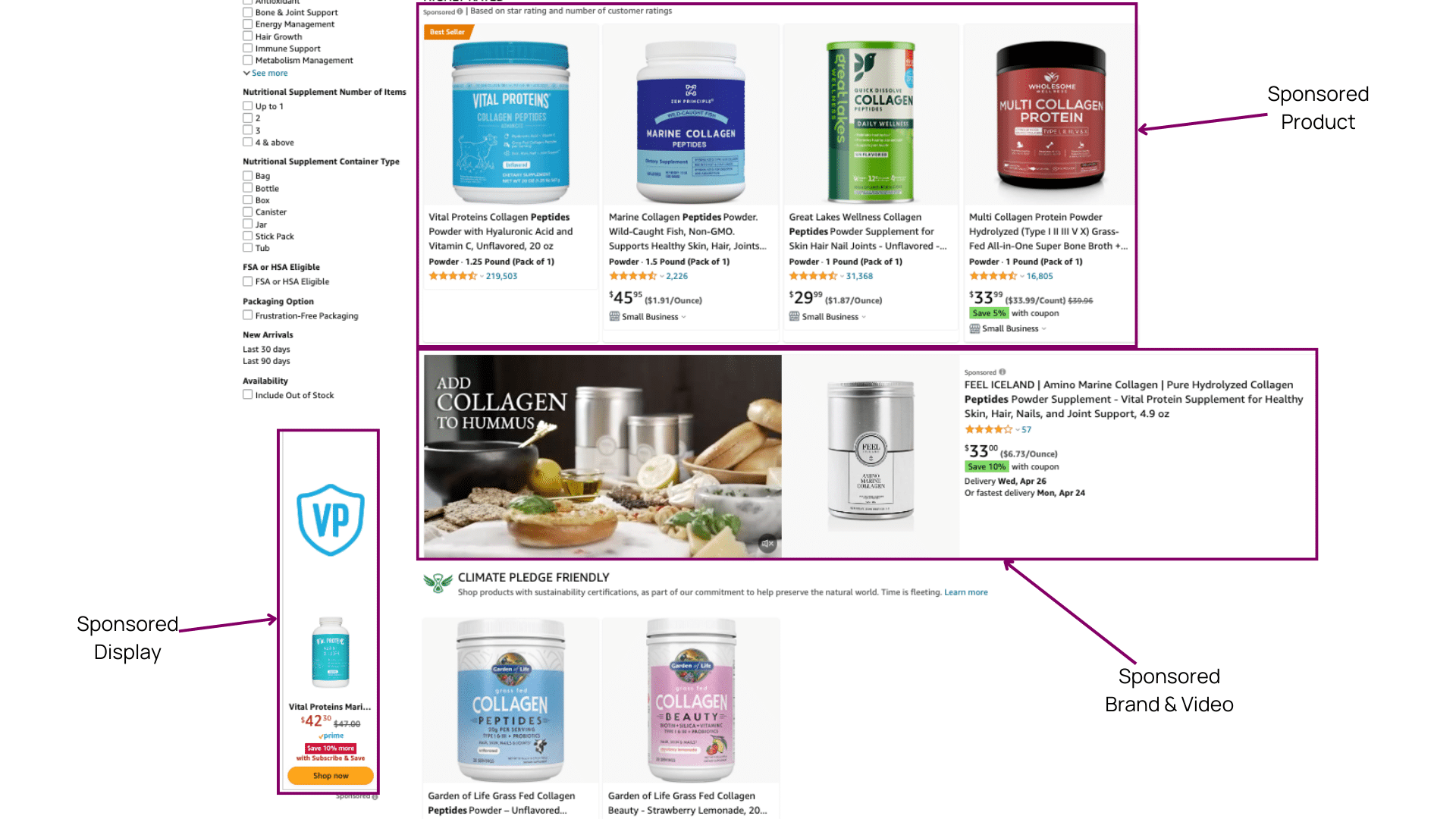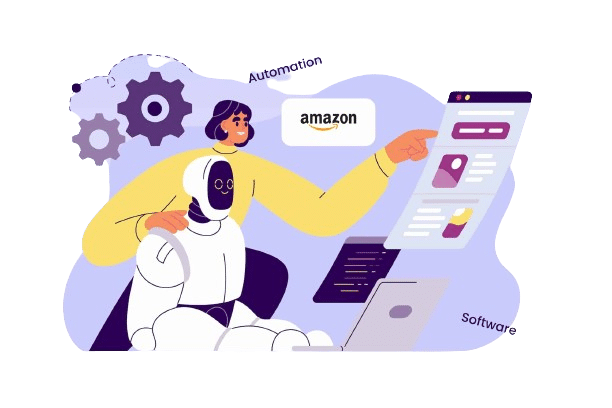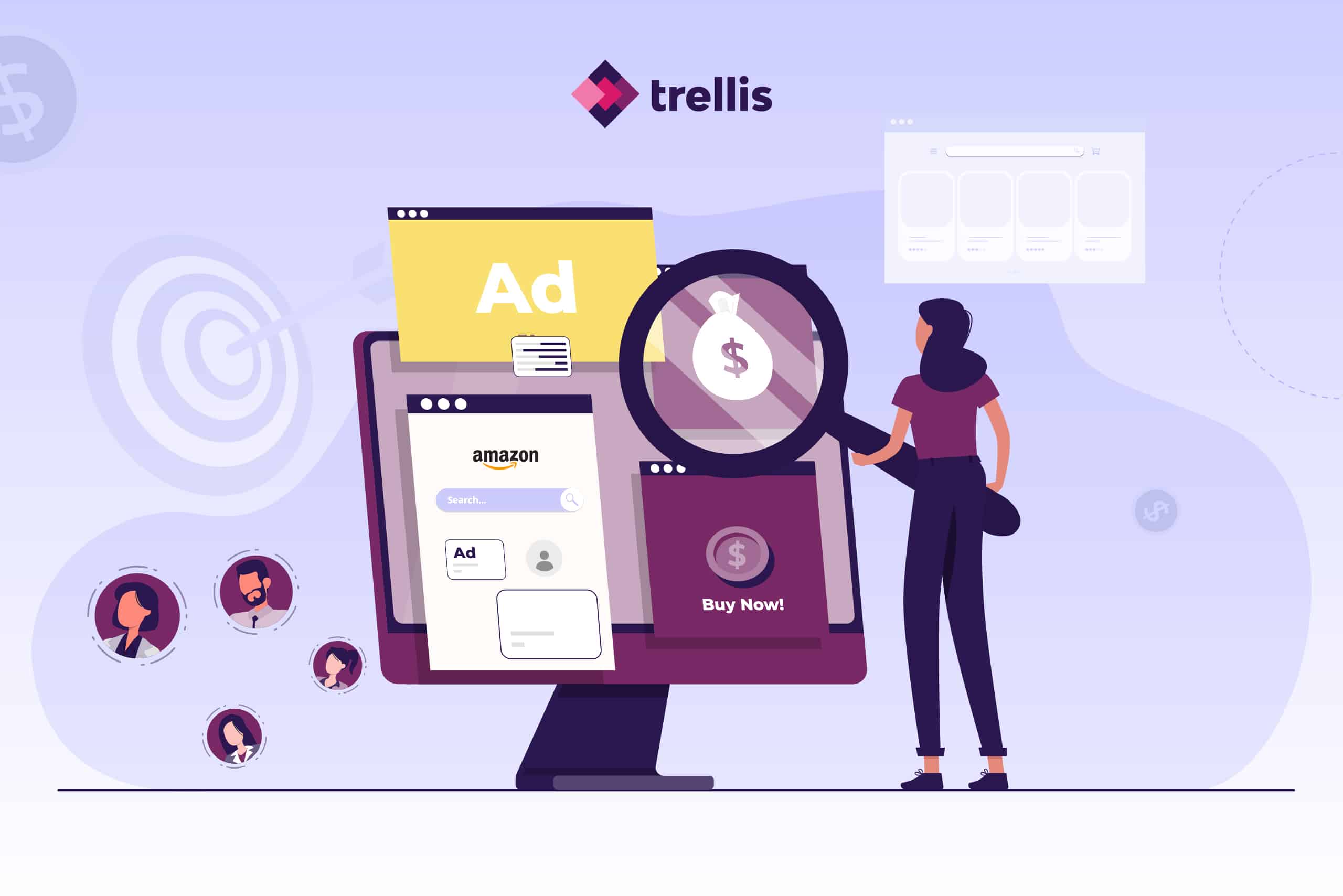Landing prime placements on Amazon is a brutal game these days. With top spots commanding eye-watering premiums, you can’t just throw money at the problem anymore. In a climate where one wrong move can mean the difference between a successful and unsuccessful campaign, growth focused sellers are using targeting strategies that balance visibility with profits.
In this guide, we’ll show you how to get more out of your Amazon ad placements and automate the heavy lifting for long-term profitability.
Choosing the Right Ad Types on Amazon
Each ad type serves its own purpose in your overall advertising strategy, with varying placements, costs, and targeting options. Understanding where each type shines is crucial to optimizing your ad spend.
| Sponsored Product | Sponsored Brand | Sponsored Display | |
| Main purpose | Product visibility | Brand visibility | Targeting specific audiences & retargeting |
| Pricing | CPC | CPC | CPC, vCPM |
| Placement | Amazon SERP, product pages | Amazon SERP, Top of Search | Homepage, SERP, product detail page, off-Amazon |
| Targeting | Keyword, ASIN | Keyword, ASIN | Audience-based, ASIN |
| Links | Product detail page | Store, product list, product detail page | Product detail page |
| Brand Registry | Not required | Required | Required |
| Format options | Product images | Static images, video | Static images, video |
If you blink, you might miss Amazon’s latest ad placement updates. The platform is constantly adding new ways for sellers to get their products in front of shoppers. For example, you can now run both static images and video creative in Sponsored Display ads—and you can run them on third-party sites.
This off-Amazon expansion lets brands showcase their products throughout the customer journey, from initial discovery to final purchase.
Download Our Free Chrome Extension
Track and analyze Amazon competitors to maximize your revenue and profits.

Sponsored Products
Sponsored Products (SP) are still the bread and butter of Amazon advertising. These ads blend into search results and product pages, making them look and feel like organic listings.
In 2023, Amazon expanded SP placements to appear on external platforms including Pinterest, BuzzFeed, and other publishers, giving brands more opportunities to capture customers at various touchpoints in their journey.
Sponsored Products lets you either hand-pick your keywords (manual) or let Amazon’s algorithm do the heavy lifting (automatic). Many sellers use both—running auto campaigns to spot winning keywords, then shifting those winners to manual campaigns for fine-tuned control.
The way you position your brand is essential to standing out on Amazon. Learn how to get it right in our guide to Amazon Brand Positioning.
Sponsored Brands
Sponsored Brands (SB) ads help build awareness by showcasing your brand story, with creative featuring your logo, a custom headline, and multiple products. These ads appear at the top of search results, product detail pages, and category pages, making them ideal for capturing attention early in the shopping journey.
Want to really grab attention? Shoppers are 95% more likely to remember your message when it’s delivered through video. Sponsored Brands video ads auto-play when half the creative hits the screen. If you’ve got a compelling story to tell, this format is your secret weapon.
Capture more shoppers in a glance. Learn how to add video to your Amazon listings, or get inspired with real examples of high-impact Amazon video ads.
Sponsored Display
Sponsored Display (SD) ads now offer a range of targeting options based on shopper behavior and interests. These ads appear across Amazon properties and third-party websites—perfect for retargeting shoppers who viewed the products in your Amazon store but didn’t buy.SD’s advanced targeting allows you to reach relevant audiences based on shopping signals, streaming behavior, and past interactions with similar products. In 2024, Amazon introduced AI image generation for SD, making it easier for sellers to use branded creative in their ad campaigns. This innovation is already showing results – sellers who implement branded creative are seeing their return on ad spend (RoAS) increase by 13.6% on average compared to those using standard creative.

What Are the Most Effective Ad Placements in 2025?
There’s no one-size-fits-all when it comes to placement strategy. It all comes down to what you’re trying to achieve with your campaigns. However, recent data highlights some clear trends across categories.
Sponsored Products consistently deliver the highest share of advertising-driven sales on Amazon, making them the cornerstone of most sellers’ strategies. Top-performing sellers often use a hybrid approach, using Sponsored Products for bottom-funnel conversion while leveraging Sponsored Brands and Sponsored Display to build awareness and retarget shoppers.
Consider these factors when planning your ad placements:
- Customer journey stage: Match placements to intent. Use Sponsored Brands for awareness, Sponsored Products for consideration, and Sponsored Display for retargeting abandoned carts.
- Seasonal timing: Adjust placement mix for peak seasons. Increase visibility with premium placements during peak season on Amazon, while maintaining profitability targets.
- Product lifecycle: Allocate spend based on maturity. For example, new launches may require a 60-70% budget in top-funnel awareness, while established products can focus 70%+ on conversion-focused placements.
- Margin structure: Calculate maximum profitable CPC for each product tier—premium items (30%+ margin) can bid aggressively for top placements, while low-margin items (>15%) may need conservative bottom-funnel targeting.
For example, to attract New-to-Brand (NTB) customers, dividing ad spend between SP and SB helps build awareness. If your goal is to drive repeat sales from existing customers, retargeting with SD is a great option.
Overall, ad performance depends on how well you optimize your ad placements. Smart sellers have moved away from lumping all keywords together. Instead, they’re creating separate campaigns for branded terms, generic product searches, and competitor-focused keywords.
After all, someone searching specifically for your brand needs a different strategy than someone comparing multiple brands or browsing general product categories. By matching your tactics to these search behaviors, you can boost your return on ad spend (RoAS).
💡Quick Tip: Finding your sweet spot for ad spend is crucial. Too little and you won’t see results; too much and you’ll eat into your profits. Not sure where to start? Check out our guide to finding your minimum RoAS on Amazon.
6 Strategies for Profitable Ad Placements
Winning at Amazon ads isn’t just about throwing money at the problem. These six strategies will help you improve your placements and keep your ad spend working harder for your brand.
1. Full-funnel Targeting
Think beyond just targeting ready-to-buy customers. Amazon sponsored ads get the best results when you target the entire customer journey, from awareness to consideration to purchase.
When you zoom out to target the entire funnel—from first discovery to final purchase—you’ll find valuable keywords at every stage. As a major bonus, many of these early-stage searches often cost less because fewer sellers are competing for them.
For example, a full-funnel strategy might include a highly specific long-tail keyword like, “3-pack toothbrush with tongue cleaner” with a 25% conversion rate with a $1.50 CPC. Your Cost Per Acquisition is $6 for these shoppers.
A more general term, “assorted toothbrushes,” might deliver a 10% conversion rate at just $0.50 CPC. This scenario yields a $5 CPA and better overall profitability, despite the lower conversion rate.
Look beyond high-intent searches and test the full funnel. You’d be surprised how many hidden gems your competitors miss by sticking to “proven” keywords.

Increase RoAS on Amazon By 100%
See how our formula improves your advertising KPIs in 8-12 weeks in almost every category.
2. Discovering Keywords for Your Products
Finding the right keywords can make or break your success on Amazon. While many sellers rely on basic research methods, a multi-pronged approach helps you uncover valuable opportunities your competitors might miss.
Here are four proven methods to build a comprehensive keyword strategy:
- Automatic campaigns: Let Amazon’s algorithm identify relevant terms based on your product listing.
- Competitor analysis: Research top-ranking competitors’ listings to extract relevant keywords from their titles, bullets, and descriptions.
- Broad match exploration: Start with core product terms in broad match to capture variations and long-tail opportunities. Monitor search term reports to find high-performing phrases worth targeting.
- Search term reports: Analyze which customer search queries lead to sales, not just clicks. Look for patterns in converting terms and add the best performers to your manual campaigns.
A popular tactic is using broad-match keywords to capture relevant variations including misspellings, synonyms, and linguistic variations. For example, bidding on “lounge sofa” might reveal high-performing related terms like “sectional sofa” or “loveseat” that you hadn’t considered.
On Amazon, you can either set up your campaigns manually by selecting broad-match or set an auto campaign by letting Amazon discover keywords that resonate most with your product listing.
Amazon advertising software like Trellis automates this entire process. Our AI analyzes your auto-campaign data daily, automatically identifies winning keywords, and creates optimized manual campaigns with strategic bid adjustments based on performance patterns.
Finding the Most Profitable Keywords
Finding profitable keywords means understanding the relationship between match types, conversion rates, and costs. Each match type serves a specific purpose in your keyword strategy:
Exact Match
- Highest precision targeting specific search terms
- Generally highest conversion rates (2-3x higher than broad match)
- Higher CPCs but often better ROI
- Example: [organic toothbrush] only matches that exact phrase
Phrase Match
- Captures relevant variations while maintaining intent
- Medium conversion rates and CPCs
- Good balance of reach and relevance
- Example: “organic toothbrush” matches “best organic toothbrush” and “organic toothbrush set”
Broad Match
- Widest reach for keyword discovery
- Lower conversion rates but valuable for research
- Usually lowest CPCs
- Example: organic toothbrush matches “natural dental products” and “eco-friendly tooth cleaning”
The key to profitability is using a systematic approach:
- Start with broad match to discover converting search terms
- Move high-performing terms to phrase match for testing
- Scale winners to exact match with optimized bids
- Continuously monitor and adjust based on performance data
💡Pro Tip: As shown in our toothbrush example, long-tail keywords don’t always deliver the lowest CPA. You have to consider the relationship between conversion rate, Cost Per Click, and overall CPA. Only through systematic testing can you identify which keywords deliver the best return on investment.
Targeting Through Advanced Analytics
Digital shelf metrics such as Share of Voice (SoV), Share of Shelf (SoS), and average ranking position help you understand your competitive position. These insights allow you to see which competitors are gaining market share and adjust your strategy accordingly rather than making reactive changes based on limited data.
Customer Lifetime Value (CLV) analysis reveals which products drive repeat purchases, which bring in new customers, and which generate the most revenue over time. This knowledge allows for more strategic bid adjustments, such as accepting higher acquisition costs for products that lead to repeat purchases.With insights from Amazon Marketing Cloud, sellers can see the entire customer journey to identify which touchpoints drive conversions.

Harvest Top Keywords For Your Products
Receive expected search volume, bid ranges, and overall keyword competition to maneuver through the Amazon results page.
3. Automating Bid Optimizations
As your product catalog grows, manual bid management becomes a quicksand of spreadsheets and constant adjustments. With just 100 products and 20 keywords each, you’re managing 2,000 individual bids. Double your catalog? That’s 4,000 bids to optimize daily.
This is where automation becomes not just helpful, but critical. Amazon offers both dynamic and fixed bidding strategies for different campaign types:
- Dynamic bids – down only: Reduces bids when conversion is less likely (conservative approach)
- Dynamic bids – up and down: Increases or decreases bids based on likelihood of conversion (aggressive approach)
- Fixed bids: Maintains consistent bidding regardless of conversion probability
The strategy you choose should always align with your campaign goals. For clearance products, you might use “down only” to maximize profit, while for new product launches, “up and down” can help maximize visibility and sales velocity.
Trellis automatically aligns your bidding strategies with your specific objectives for each product, applying the right approach based on its lifecycle stage and performance targets. The platform then uses AI bidding based on real-time campaign performance data, increasing placement bids for converting keywords and reducing them for underperformers.
4. Managing Budget Efficiently
Budget allocation has a significant impact on advertising performance. Of course, you should allocate more budget to high-performing campaigns than poor-performing ones, right?
Not always. Doubling down on high performers makes sense from an efficiency standpoint, but that may not always be your top priority. Here are a few perspectives to consider in terms of strategic budget allocation.
Your budget allocation should align with your strategic goals:
- Sales growth: Direct more budget to high-converting products.
- Profitability: Focus on high-margin products.
- Brand awareness: Prioritize Sponsored Brands ads.
For sellers with a wide catalog of products, knowing how to optimize advertising across a range of products or brands is essential for effective budget management.
5. Explore Dayparting
Ad performance varies significantly throughout the day and week. While some shoppers purchase more during daytime hours, ads may be more cost-effective during evening periods when competition decreases.
The Serving Hours Dashboard in Trellis helps you identify optimal bidding times to run ads with the highest return on investment potential.
Automating budget allocation ensures your spend flows to the campaigns with the best profitability—i.e. with the best Advertising Cost of Sale (ACoS).
What’s your target ACoS? Calculate it in seconds with our free Amazon ACoS calculator.
6. Using Budget to Control Inventory
Align your ad budget with your inventory management strategy to avoid lost sales or excessive storage costs due to stockouts or overstock:
- If inventory is low, reduce ad spend to slow sales velocity until replenishment.
- When overstocked, increase advertising to accelerate sell-through.
- During promotional periods, align ad spend with projected demand spikes.
This coordination between advertising and inventory prevents the reputation damage of stockouts while optimizing working capital efficiency. Plus, consistent inventory levels are key to winning the Buy Box.
3 Steps to Optimize Your Amazon Ad Placements
Effective ad placement that delivers consistent results requires a systematic approach. Here’s a proven workflow.
1. Collect the Data and Segment It
Start by consolidating data from across your advertising, sales, and marketplace analytics. Look for patterns that reveal opportunities and risks:
- Search term reports: Identify high-performing keywords
- Product performance reports: Spot products with strong repeat purchase rates
- Campaign reports: Determine which ad formats and placements drive the best results
- Brand analytics: Track changes in share of voice and category trends
This holistic view allows you to segment your products based on their performance characteristics and align them with appropriate strategies.
For example, if your toothbrush brand wants to increase market share, you might analyze:
- Search term reports to find high-converting keywords for toothbrushes
- Product performance data to identify which models drive repeat purchases
- Campaign reports to determine which ad placements deliver the best engagement (click-through rate, video completion)
- Brand metrics to spot declining share of voice in the toothbrush category
By combining these insights, you can develop a targeted strategy to boost market share by promoting your best-performing products in the most effective placements.
2. Implement the Best Variables for Your Objective
Based on your analysis, choose strategies that align with your goals:
- If seeking growth, prioritize high-visibility placements and broader keyword targeting
- For profitability, focus on high-margin products and precise keyword matching
- When launching new products, emphasize Sponsored Brands to build initial awareness
In the toothbrush example, you might allocate budget to Sponsored Product and Sponsored Brand Video ads, targeting “best selling toothbrush” as a keyword and increasing bids for top-of-search placements to maximize visibility.
3. Measure Results and Optimize Further
Continuous refinement is essential for long-term success. Establish clear performance benchmarks and regularly assess how your campaigns compare. Here are some questions to consider:
- Which ad placements deliver the lowest acquisition costs?
- How do different creative approaches impact conversion rates?
- Are certain products performing better with specific ad formats?
Use these insights to optimize your Amazon PPC campaigns and increase profitability over time.
Upgrade Your Amazon Ad Strategy With Integrated 4P Management
Balancing top-funnel awareness and bottom-funnel conversion tactics can be tricky. Trellis’s Placement Max algorithm helps brands analyze which placements and funnel stages deliver the best results for each product category and automatically adjusts your campaigns.
Take the guesswork out of ad placements by directing your spend where it will deliver the best performance—whether that’s in Amazon search results, product pages, or even off-Amazon through Amazon DSP.Ready to boost your profitability on Amazon? Book a demo with our experts today.






